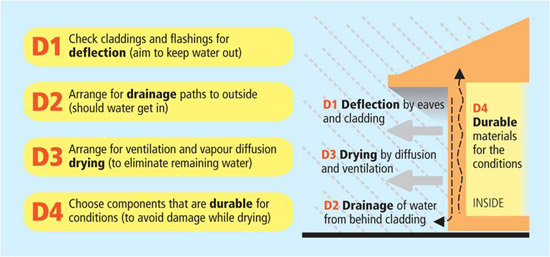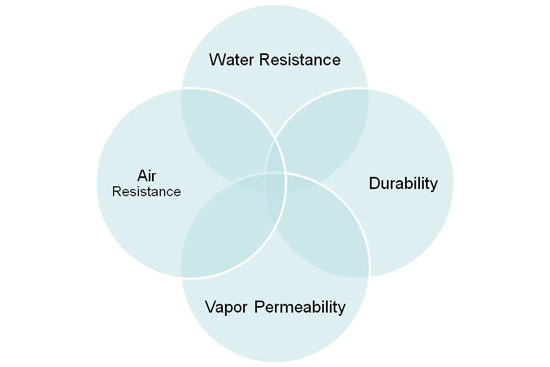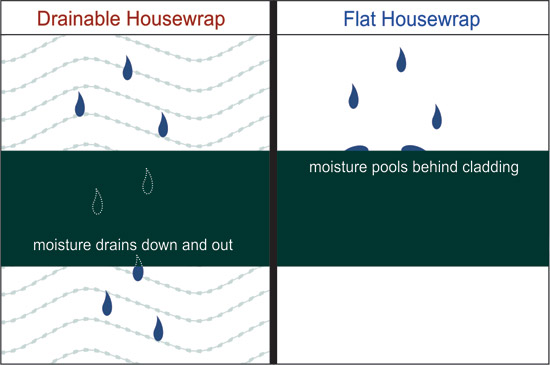Drainage and Drying in Low- and Mid-Rise External Walls
Water Resistive Barriers
Moisture management is about removing water and water vapor from wall assemblies as quickly as possible, before they can cause damage. This is achieved by deflection, drainage, drying and durability of materials used.
While exterior cladding is usually considered to be the primary barrier to water entering a building enclosure, no cladding can keep out all the water. Expansion and contraction of siding create gaps in exterior surfaces, while intersections, joints and wall penetrations can allow water infiltration.
 |
The four Ds of moisture management methods are deflection, drainage, drying and durability. Source: Department of Building and Housing, Wellington, New Zealand |
Water resistive barriers, part of a building’s exterior wall system, are designed to prevent air and water from entering the stud wall cavity from the outside. They also allow the free passage of water vapor to the outside of the building so that the framing and wall cavity can dry, thereby reducing the threat of mold and rot. In effect, they perform like a shell for buildings—liquid water that has penetrated the exterior finish does not pass through, yet water vapor from the interior can escape. By keeping building materials dry, a water resistive barrier helps improve building durability, decreases maintenance costs and reduces the risk of moisture-related problems.
In addition, when installed as an air barrier that prevents hot and cold air movement through the wall cavity, water resistive barriers help reduce utility costs and increase comfort by reducing air infiltration and potential drafts. There are three basic types of water resistive barriers on the market: building papers, flat housewraps and enhanced drainable housewraps. The focus of this CEU is on water resistive barrier products.
Building Papers and Felt
“Asphalt saturated kraft” (ASK) paper or building paper is made from new wood pulp, and has been a staple for years. “Felts” are made from recycled paper products, rag felts and sawdust, and are also impregnated with asphalt. One of the unique features of building and felt paper is that they tend to increase the passage of moisture vapor into the wall assembly when they become wet. Another is that they tend to wrinkle when exposed to wetting and drying cycles; when installed in two layers, wrinkling can create a drainage gap between the two layers.
Standard/Flat Housewrap
Housewrap generally refers to synthetic sheeting that is wrapped around a house to protect against moisture infiltration. Like building paper or a fluid-applied barrier, housewrap is a water-resistive barrier (WRB), and, like all WRBs, it has one primary function: resisting the infiltration of water.
Plastic housewraps entered the market in the 1970s, prior to which asphalt saturated papers and felt were the predominant form of a WRB. They have become increasingly popular and are now the product of choice for low- and mid-rise buildings because of their ease of installation, durability, and their ability to block water that has penetrated the exterior cladding from moving further into the wall assembly. Installed behind siding, housewrap prevents wind-driven rain and water from reaching the sheathing and framing; and when installed as an air barrier, prevents air infiltration, thereby helping to reduce heating and cooling costs.
In addition to resisting initial moisture infiltration, housewraps go a step further by helping to remove trapped moisture from the building enclosure. They provide a vapor-permeable layer that resists liquid water from the outside, while also allowing water vapor to escape the assembly, thus enabling the wall to “breathe” (for example, if water vapor is driven from the interior to the exterior during a heating season, the housewrap will allow the vapor to escape).
To summarize, housewraps:
• create a weather barrier behind exterior cladding while protecting the sheathing.
• provide a vapor-permeable membrane that allows moisture trapped in sheathing to escape.
• are an energy-efficient air barrier that reduces air infiltration into the building.
 |
Standard flat housewraps have traditionally been evaluated according to the above key characteristics. Diagram provided by Benjamin Obdyke |
Enhanced Drainable Housewrap
While earlier housewrap products kept water off structural sheathing and framing, they did not prevent the latter from deteriorating as a result of retained wetness. To avoid rot, water must be permitted to drain away from the sheathing surface. Recognizing this, building scientists and building code authorities are becoming aware that walls need to drain, and that, going forward, housewraps will increasingly be judged by how effectively they provide positive drainage of water from building walls.
Rainscreens—achieved by constructing an air space immediately behind the exterior cladding—provide drainage and drying. They may be required in high rainfall windy areas and can be used in conjunction with a housewrap. But unlike drainable housewraps, rainscreens require a design change to the wall/siding assembly and an additional construction step.
 |
Efficient drainable housewrap have spacers, which allow moisture to drain down at a faster rate compared with moisture draining from flat housewrap. Provided by Tamlyn |
Drainable housewraps, the fastest-growing segment of the market, address this need by incorporating both a water-resistive layer and a drainage space, there by greatly facilitating water drainage from behind the exterior cladding system.
Unlike typical housewraps, which provide only a water-resistive layer and can trap water behind cladding, drainable housewraps provide a continuous drainage space that allows water to escape at a faster rate from the wall system, thus protecting the building enclosure. In addition, a typical drainage housewrap provides drainage channels that form an unobstructed path behind cladding, thus avoiding the possibility of “ponding” along siding edges, which can happen with traditional flat WRBs.
These enhanced products provide a much higher and more constant drain rate than flat housewraps. Compared to flat housewraps, the newest drainable housewraps–especially those that provide a minimum of a one (1mm) millimeter gap–can be as much as 100 times more effective at removing bulk water from the wall. One drainable housewrap on the market provides a 1.5 mm gap.









